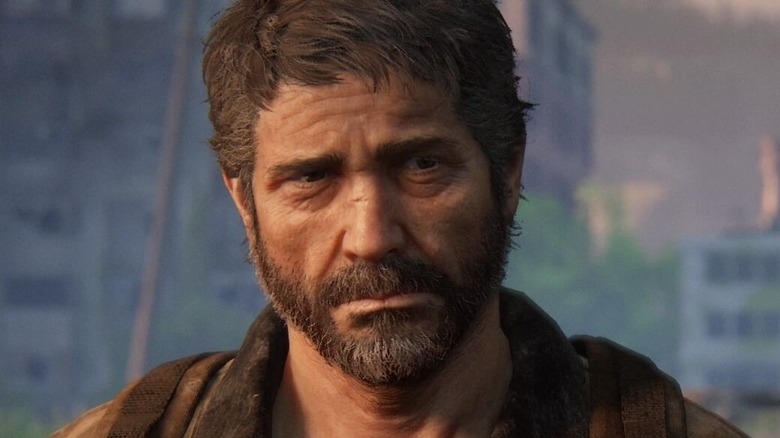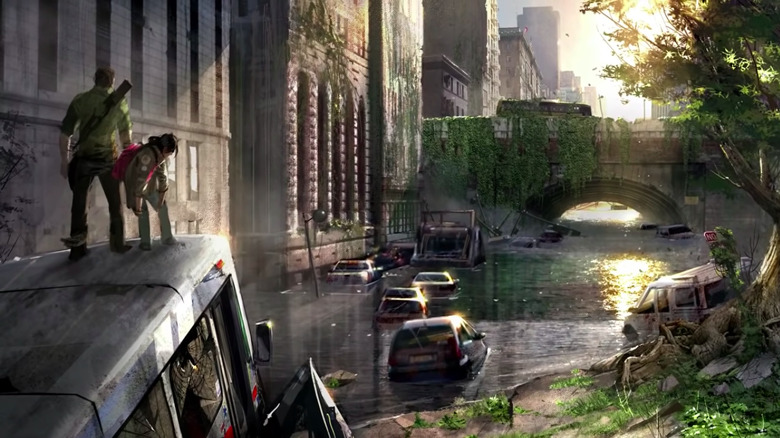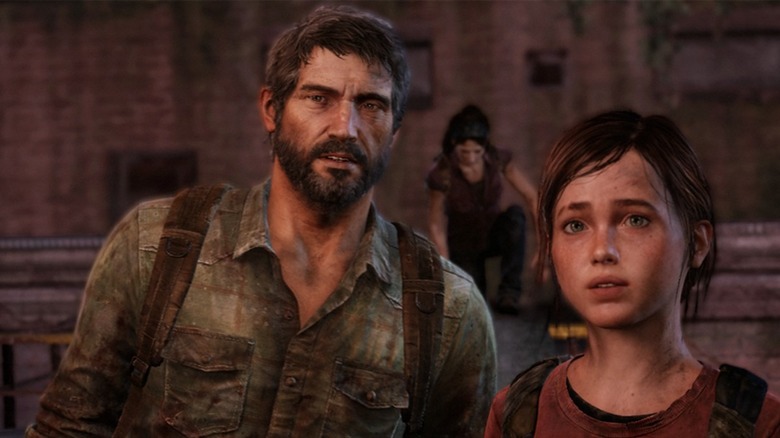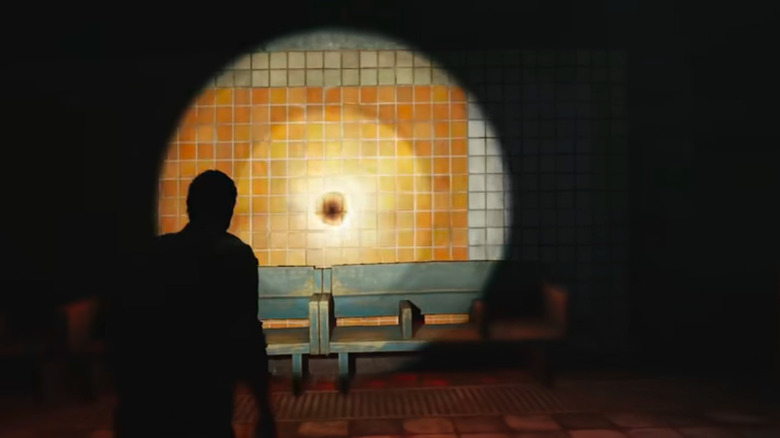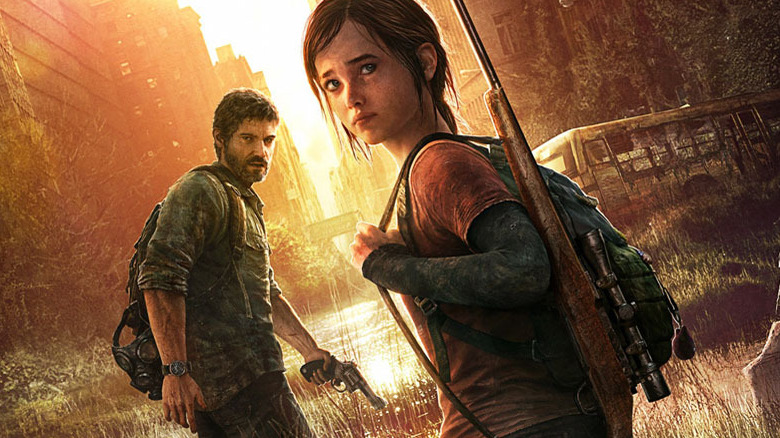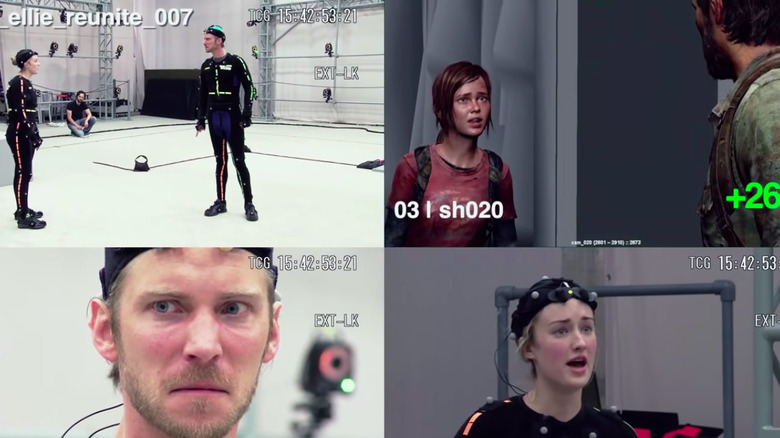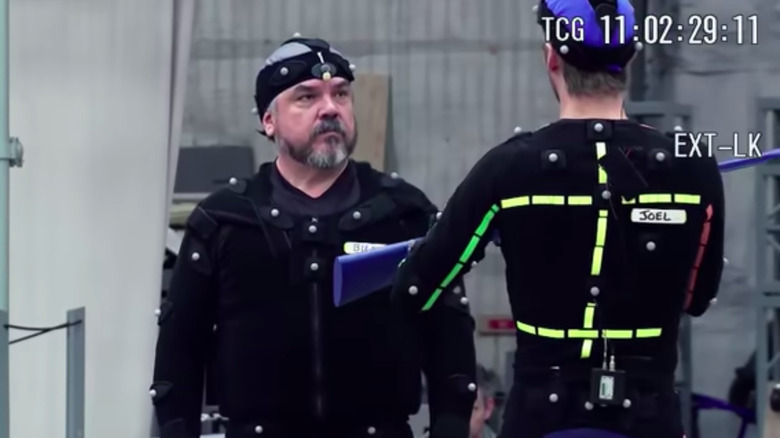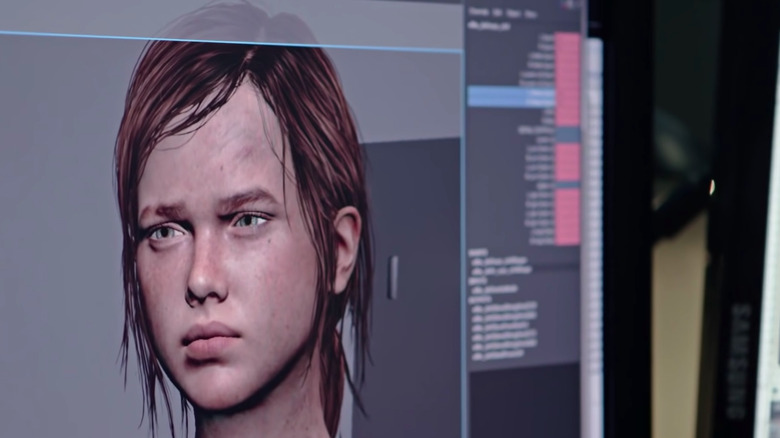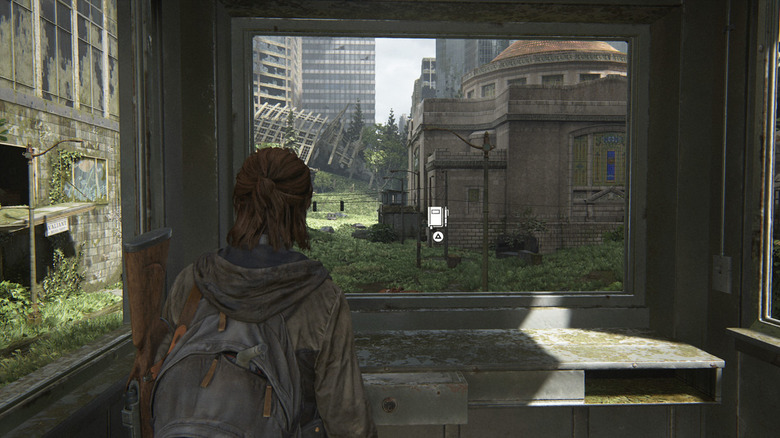What The Last Of Us Looks Like Without Special Effects
Thanks to games like "Crash Bandicoot" and "Uncharted," Naughty Dog was already an established force in the gaming world when "The Last of Us" was released in 2013. Despite that, there was a real sense that the game could end up being a failure for the studio. "With this, I was more unsure," said creative director Neil Druckmann in an interview with Jason Killingsworth. "I wasn't sure if people would pick up on it, or how they would read it."
Druckmann didn't need to doubt. "The Last of Us" released to rave reviews from players and critics alike. The game has an astounding 95% score on Rotten Tomatoes and swept up numerous awards across the industry. "The Last of Us" spawned a sequel and inspired an acclaimed HBO series.
That said, the reasons behind Druckmann's uncertainty are clear to see. "The Last of Us" is a deeply intimate, stripped-down experience with a commitment to realism not often seen in video games. From the story, to the character design, to the look of every item and building strewn across its levels, "The Last of Us" aims to create a reality that is instantly recognizable. With all the effort and technical ability put into the game, "The Last of Us" more than achieves that goal, but here's what the game looked like before the expensive animation and special effects.
Designing the infected
While "The Last of Us" doesn't technically take place during a zombie apocalypse, the developers realized early on that players needed some kind of infected enemy to fight against. In the documentary "Grounded: The Making of 'The Last of Us'," the game's designers explained that they momentarily considered having the infection at the center of the story simply kill people, but they quickly came to understand that without infected humans to fight, players would never truly feel the impact of the disease.
When creating the infected, the developers said they became inspired by watching a documentary that discussed the cordyceps fungus. Cordyceps infects the bodies and brains of insects, taking control of their bodies to move to a more ideal location to grow. The designers leaned into this concept and used pictures of fungal and other infections as inspiration for the game's creatures. They wanted to make the infected look recognizably human while still being obviously overrun by the fungus growing inside them — sometimes even having their faces cleft by sprouting fungal nodes. The result is one of the most iconic and disturbing "zombie-esque" creature designs of all time.
A world without us
It wasn't enough for the humans and the infected in "The Last of Us" to feel real. Naughty Dog wanted to create an apocalyptic landscape that felt eerily like a future possibility. In "Grounded" Neil Druckmann explains how the team spent time researching what happens to the infrastructure of human cities when there aren't humans around to maintain things. They drew heavily from Alan Weisman's book "The World Without Us" to develop the flooded, overgrown, and crumbling city landscapes featured in the game. In an interview with Jason Killingsworth, game director Bruce Straley said the team also pulled from images of Chernobyl, Pripyat, and New Orleans after hurricane Katrina.
Thanks to the "Uncharted" franchise, Naughty Dog was no stranger to crafting ruined structures that nature had worked to reclaim. The difference was that the ruins in "The Last of Us" represent a lost world that most gamers could easily recognize, rather than ancient ruins from an unknown civilization. This made the experience more emotional for players, but it also required Naughty Dog to look at their environments with hopeful eyes.
Lead game designer Jacob Minkoff describes in the film an early piece of concept art that showed animals freed from a zoo roaming the ruined cities. "That's something that tells you life goes on," he says, "and this world is worth saving." The design of the world gives players an immediate sense of the importance of Joel's and Ellie's mission, and turned the studio's green screen sets into a harrowing (but realistic) post-apocalyptic landscape.
Designing the humans
Video game characters are often hyper-stylized in some way or another. With "The Last of Us," however, Naughty Dog set out to create characters that felt like real human beings. Troy Baker, the actor who plays Joel in the game, has talked about how anti-heroes like Joel are typically viewed as "the thick-necked mercenary," but that for this game "we needed something new" (via "Grounded"). Joel is a hardened survivor, but he ultimately looks like an average man getting on in years.
The decision to stay more true-to-life emphasizes the power that real human individuals have, and it energized the actors who joined the project. Ashley Johnson, who plays Ellie, said, "To sort of be such a strong female character that is completely normal-looking, regular t-shirt and jeans, and she's fourteen, and she's still a total badass. It's really exciting to be a part of that."
The image of Ellie as an extremely capable (but still learning and growing) fourteen-year-old girl is an essential element of the game for creative director Neil Druckmann — especially since Ellie would eventually become a playable character. Druckmann went on to explain that Naughty Dog had lied about gamers playing as Ellie in the run up to "The Last of Us". The company wanted that to be a surprise and for players to get the chance to connect with her organically, free of any presupposed notions.
Lighting makes the game
Lighting is a major challenge for any game. Different lighting effects can make or break the look of a game, and having too much or too little light in an environment can ruin a player's experience of it. In the post-apocalyptic world of "The Last of Us" lighting was even more of a challenge because the designers needed to rely primarily on natural light from the sun pouring into environments. To maintain the realistic feel of the game, designers made Ellie, Joel, and the other characters always cast shadows around them as they moved, even in low-light environments.
Some areas in the game are so dark that players need to rely on a flashlight. The lighting designers didn't want the sudden intrusion of light to break the game's immersion, so they worked to make the flashlight look as realistic as possible. Its light shines in an uneven gradient, and when players aim the flashlight at colored surfaces, that light is reflected onto the rest of the environment. "It's very difficult to do. It's very expensive to do, but we did it," said Vivian Ding, the game's lead lighting artist (via "Grounded"). Their hard work paid off. As IGN's review said of the game, "[Its] graphical beauty makes the events of 'The Last of Us' overflow with realism."
This was the missing piece to bring the environments of "The Last of Us" to realistic life. Without this attention to realistic detail in the lighting, the game would either be impossible to see, or the immersion would be broken.
Casting Joel and Ellie
When it came to actually casting the game, Neil Druckmann said, "It took us a while to find our Joel, but for Ellie, I think Ashley was the second or third candidate to walk in, and right away we knew." She looked and sounded just right for the part, and Ashley Johnson related very strongly to Ellie when she first read the script. "I read the scenes, and I was like, 'I need to play this part,'" Johnson said.
Troy Baker's casting as Joel wasn't as clear of a decision for Druckmann and the others working on the game. Unlike many of the other actors coming to audition, Baker didn't really line up with Joel's look or age. "I walked into the room fully aware that I was the youngest person they were seeing for this role," Baker said in an interview. When he started speaking, though, the casting team found themselves convinced he could be right for the job — and his physicality in the audition seemed right for the role.
By that point, the casting department had Ashley Johnson reading with the actors auditioning for Joel, and when the team saw the chemistry she had with Baker — even against a blank background and without any of the finished game's set decoration — it was a done deal.
Mocap and audio were recorded simultaneously
Much of the time, when actors in video games or movies are recording motion capture, what they're saying on set isn't all that important. Actors run through their lines to keep the scene on the rails, but they know that they'll be going into a vocal booth to dub over their lines in the future. Naughty Dog took a different approach with "The Last of Us" and primarily recorded dialogue and motion capture at the same time, making the process feel more like shooting a live action movie than recording for a video game.
Neil Druckmann explained in "Grounded" why that decision was so important to the game: "Having the actors perform as well as being recorded at the same time was imperative ... every time you split up the performance in any way, you lose some of that magic."
Druckmann wanted to ensure that players connected with the performances on the screen, even if that was strictly at a subconscious level. "It gives you the most authentic, most realistic performance," Troy Baker said of the filming strategy. As fans can see in behind the scenes footage of the process, this method also gave the actors a truly unique opportunity to add their own body language and performance choices to the scenes in the game.
Actors were allowed to improvise
So, if the actors were being motion captured and recorded at the same time, were they allowed to improvise? Absolutely. Neil Druckmann and the team at Naughty Dog had carefully scripted all the scenes for the games, but actors were allowed to follow their impulses in the moment. Not only did that leeway give more life to their performances, it also made the working environment that much more fun to be in.
"Doing this was a whole lot like being five, playing in the backyard with a stick, you know," explained W. Earl Brown, the actor who plays Bill in the game — and who clearly had fun playing with the props handed to him.
Sometimes, the input actors gave Neil Druckmann about specific scenes ended up dramatically shifting the personalities of different characters. In one of the first scenes filmed with Ashley Johnson and Troy Baker, Joel was being attacked by one of the infected, and in the script Ellie was supposed to watch in terror until he freed himself. After several takes, Johnson told Druckmann "I feel like I'd hit [the infected]," and the two of them reworked the entire scene.
Druckmann later said, "We didn't have it right initially. She needs to be more capable than initially we thought she would be, and actually that made us go back and rethink combat, and rethink a lot of the areas in the game." This new direction is reflected in the addition of Ellie's knife, which Johnson can be seen wielding in many behind the scenes shots.
Facial expressions were hand-keyed by animators
Naughty Dog spent time and money making sure that the team on "The Last of Us" had high tech equipment for bringing the game's characters and their world to life. CGI, cameras, and motion capture were obviously a huge focus from the studio, but when it came to filming, there was one thing the studio didn't have. As explained in "Grounded," every facial expression in the game is "hand-keyed" by the animation team.
Animators would watch the recording of each actor's performance and use their own tools to create facial expressions on the character models. Sometimes they would need to exaggerate certain expressions or gestures, all so the end result would come through as clearly in the game as they would in real life.
When working on "The Last of Us Part 2," Naughty Dog upgraded its motion capture tech. The company wanted to allow for the facial and eye movement tracking that had been absent in "The Last of Us," which allowed the animators order to capture even more detail about the characters and the actors' performances. Behind-the-scenes footage from the sequel shows actors wearing helmets fitted with specialized cameras and having dot matrices marked on their faces to allow a computer to simulate their expressions on a character model.
The Last of Us' un-animated alternate ending
Not every scene makes it into the final product. Plans can change even after filming has begun, and sequences are often trimmed or completely removed in order to help with pacing or continuity. Much like in moviemaking, sometimes whole video game motion capture sessions are left on the cutting room floor. "The Last of Us" is no different, as seen in an alternate take of the game's climactic ending that was never fully animated.
As Neil Druckmann explains, Joel was originally meant to execute Marlene in the ER before rescuing Ellie, rather than meet her for a final confrontation in the hospital's parking garage. Multiple takes of this scene can be viewed in behind the scenes footage, showing Troy Baker and the other actors in various stages of distress (and even a blooper or two). This was a physically demanding sequence, requiring Baker to grab one of the doctors as a hostage before shooting his way out. As seen in the footage, Baker kept dropping his prop gun in the scuffle, necessitating a reset.
Ultimately, the choice was made to simply allow the player to choose which of the doctors to shoot, as well as to buy Marlene just a little bit more time. Still, these mo-cap sessions offer a fascinating glimpse at the finale that could have been.
Mapping real environments
When it was time for work on "The Last of Us Part 2" to officially start, the entire team at Naughty Dog knew that they wanted to emphasize the sense of realism that had blown players away in the original game. In addition to adding facial tracking to their recording and giving the game's graphics a boost, the team also went to insane lengths to make the game's environments as true-to-life as possible. In a behind-the-scenes video, one of the developers says, "We took three trips up to Seattle. We actually got photo scan data of, like, natural elements in the forest, and went through and walked the path of Ellie through Seattle to actually get as much reference as we could." Much like the first game, these references turned the blank sets into a lush and immersive environment.
A huge amount of effort went into gathering reference material for the game's design. In the same video, Neil Druckmann explains that the team did research on specific foliage and architectural styles present in the real-world areas that the game simulates. Their efforts make "The Last of Us Part 2" feel bigger than its predecessor in every way, while still staying true to the core elements that made the original such an incredible success.
Upping the ante
For all its ambition and beauty, "The Last of Us" was a very stripped down game that focused on basic mechanics and subtle storytelling. Much of that is true of "Part 2" as well, but in some areas Naughty Dog decided to crank up elements of classic video games. Because of that, "The Last of Us Part 2" features a true boss battle in the form of the franchise's most terrifying monster: the Rat King.
In an episode of IGN's "Art of the Level," character concept artist Hyoung Nam and character concept director Ashley Swidowski detailed the evolution of the Rat King. They started with the basic idea of a hulking mass of trailing bodies hungrily chasing players down, but they weren't sure how large the creature needed to be. Nam said it was Neil Druckmann who first suggested the idea of multiple infected bodies crumbling together to form a new creature, and that gave Nam the idea for the shape of the Rat King. From there, he designed it with the idea that it was "a force of nature." By having a group of performers push along a massive frame and act as the various limbs of the creature, they were able to make this impossible beast a reality.
Later footage in the episode shows how the Rat King's in-game reveal was based around the audio of the motion capture footage. The designers wanted players to hear the Rat King first, to give them a just a second to know something horrible is coming before it arrives. The combination of the actors' audio and timing along with Nam's and Swidowski's art direction created the most unforgettable creature in "The Last of Us" franchise.
Motion capture animals
Most of what happens in the motion capture studio is pretend. As seen in the case of Ellie's signature knife, actors typically hold sticks or plastic props instead of guns and blades. They scale foam blocks instead of walls and fall onto pads instead of the cold, hard ground. That's partly for safety, of course — no one needs to accidentally get stabbed while filming a fight — but it is also due to the difficulty of capturing details smaller than the movements and gestures of human bodies.
Some interactions, though, just can't be faked. Footage from the motion capture sessions for "The Last of Us Part 2" show how Naughty Dog created such lifelike animal motions and interactions between humans and animals. The team actually brought horses and dogs into the studio and fitted them with their own makeshift mocap suits to get the movements as realistic as possible. With the help of trained animals, the team behind "Part 2" was able to bring in-game animals to life at a whole new level. Plus, who doesn't love seeing dogs in funny outfits?
The Last of Us: One Night Live
On July 28, 2014, Naughty Dog hosted a show called "The Last of Us: One Night Live." The performance, which can be seen almost entirely on YouTube, gave several original cast members the opportunity to perform scenes from the game for a live audience, along with music from composer Gustavo Santoalalla. The show also included a special epilogue scene set after the events of the game, which was eventually adapted as a particularly heartbreaking scene in "The Last of Us Part 2." Though the footage of this particular scene still hasn't been officially released to the public, PlayStation's video of the event is worth checking out for fans of the first game.
The show was performed with sparse sets and a soaring use of physical props, allowing the actors to really embody their characters and guide the audience through some of the most heart-wrenching moments in "The Last of Us." Troy Baker, Ashley Johnson, Merle Dandridge, and Hana Hayes all reprised their parts from the original game, while Annie Wersching reprised the role of Tess and also played Ethan and Jerry Anderson. If you ever wanted to see what "The Last of Us" really looks like without special effects, this is it.

